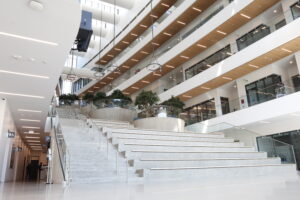
On the evening of the summer solstice this past Saturday, June 21, SFU’s Burnaby campus celebrated the opening of a new Peace Labyrinth with a free public ceremony that included activities such as spoken word performances, traditional words of wisdom, and a candle-lit walk through the labyrinth.
The labyrinth has been mown into the turf field adjacent to Strand Hall, located just beside Cornerstone. It is a single path walkway in a circular pattern that leads you to its centre and back. Traditionally, the walk can be either a solo journey, or a shared experience walking with friends.
Coordinator of the SFU Centre for the Comparative Study of Muslim Societies and Cultures (CCSMSC), Ellen Vaillancourt, lobbied for the idea of a highly accessible labyrinth on campus for the enjoyment of the entire SFU community. The project was approved Spring 2014, but last weekend her vision became reality.
The labyrinth is an ancient archetype that symbolizes the significance of journey and is sometimes used as a “method of discernment.” A person will enter the labyrinth with a question or a burden on their mind with the goal of finding resolution.
Vaillancourt was aided in her venture by The Labyrinth Society, an organization dedicated to the creation and maintenance of labyrinths globally, in order to provide people with the “opportunities to experience transformation” while walking through labyrinths.
“I believe we all have the opportunity to be transformed by journey and make a positive difference,” said Vaillancourt in a media release.
Celeste Snowber, an associate professor at SFU in the Faculty of Education explained that part of what makes walking a labyrinth unique and significant is the emphasis on process over product — it forces the walker to slow down.
“We’re living in this constant accelerated pace,” she continued. “It shifts your relationship to rhythm and time, and so you’re slowed down. Even that allows you to be present in a different way and we’re not often very present — we often live from our head, up.”
Snowber also spoke to the peace component of the Peace Labyrinth: “We talk about peace, but really, we don’t have that much within ourselves. The labyrinth can invite someone into a different relationship with themselves.”
The event concluded with a sun salutation at sundown, but the labyrinth remains mown into the lawn, providing what Snowber calls “an incredible tool.” Despite the simplicity of its make-up — patterns in the grass — she believes that “sometimes the simplest things are the most profound.”
The labyrinth is something that anyone can use. Snowber stressed that you don’t have to be of a certain belief to participate, and even intends on using it in her classes.
For Snowber, the labyrinth has a special significance for the SFU community: “I think it has an incredible connection to SFU. We talk a lot about engagement. And we see engagement as engaging in the world, but I think the first thing we need to do is engage with ourselves.”














